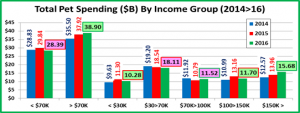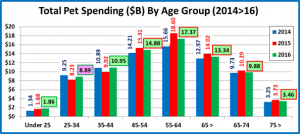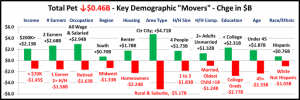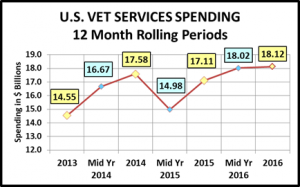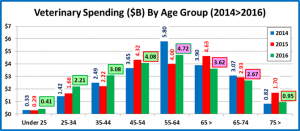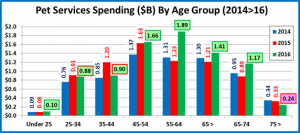2016 U.S. TOTAL PET SPENDING $67.29B…DOWN ↓$0.46B
In 2016 Total Pet Spending in the U.S. was $67.29B, a $0.46B (0.7%) decrease from 2015. This was a marked contrast from the Total “Relevant” Retail Market (+3.6%) and the Top 100 U.S. retailers (+4.2%). However, the story gets a bit complex. In 2015, a $5.4B increase in Pet Food Spending, which came from a significant share of H/H’s upgrading to more premium products, drove a 5.3% total industry increase. However, to help pay for the increase, consumers cut back on Pet Supplies and Veterinary spending, -$2.6B. In 2016, consumers began value shopping for their expensive food and reduced Food spending by $2.99B. They spent most, but not all, of this “saved” money in other Industry segments.
- A big $2.99B (-10.1%) cut back on Food
- A 0.94B (+6.3%) comeback in Supplies
- A $1.01B (+5.9%) turnaround in Veterinary
- A business as usual $0.58 (+9.3%) gain in Services
Let’s see how these numbers blend together starting at the household level. In any given week, 27.1 Million U.S. Households (1/5) spend money on their Pets – food, supplies, services, veterinary or any combination.
In 2016, the average U.S. Household (pet & non-pet) spent a total of $519.57 on their Pets. This was a 1.6% decrease from the $528.17 spent in 2015. However, this doesn’t “add up” to a 0.7% decrease in Total Pet Spending. With additional data provided from the US BLS, here is what happened.
- 0.9% more H/H’s
- Spent 5.6% less $
- 3.6% more often
If 65% of U.S. H/H’s are pet parents, then their annual H/H Total Pet Spending is $799.34. Let’s look at the recent history of Total Pet Spending. The rolling chart below provides a good overview. (Note: All numbers in this report come from or are calculated by using data from the US BLS Consumer Expenditure Surveys – The 2016 Total includes Veterinary Numbers from the Interview survey, rather than the Diary survey due to high variation)
- In 2015, the Food upgrade began early and continued all year. The cut backs on Vet & Supplies spending happened immediately and were most noticeable in the first half while Food Spending was still building.
- In 2016, we have almost the opposite scenario. The consumers began value shopping for food and this behavior became widespread by yearend. Veterinary spending saw the biggest spending lift in the first half while the more discretionary Supplies Segment didn’t “catch on” until later in the Year.
- 2016: 1st Half ↑$0.55B;
- 2016: 2nd Half ↓$1.01B
Let’s look at some Demographics. First, 2016 Total Pet Spending by Income Group. The chart has these highlights:
- If outlined in green, sales were up in 2016
- If outlined in red, sales were down in 2016
- If highlighted in green, sales were up from 2014
- If highlighted in pink, sales were down from 2014
- < $70K – (63.0% of U.S. H/Hs); H/H Pet Spending: $346.68, (-3.7%);
- Total Pet $ : $28.39B, ↓$1.45B (-4.8%) from…
- Food ↓$2.05B
- Supplies ↑$0.49B
- Services ↑$0.40B
- Veterinary ↓$0.29B
- A significant portion of this price sensitive group chose to upgrade their Pet Food in 2015. In 2016 they value shopped for food and some may even have backed away from the upgrade. Strong inflation is always an issue in their Veterinary spending. However, they did use a portion of their food savings on Supplies & Services.
- Total Pet $ : $28.39B, ↓$1.45B (-4.8%) from…
- >$70K – (37.0% of U.S. H/Hs); H/H Pet Spending: $816.00, (–2.3%);
- Total Pet $: $38.9B, ↑$0.99B (+2.6%) from…
- Food ↓$0.94B
- Supplies ↑$0.46B
- Services ↑$0.18B
- Veterinary ↑$1.29B
- This group is growing, up 4.8% in 2016. This is significant because although they spent less per H/H, their total Pet Spending $ went up. They do have higher incomes, but they still value shopped for Pet Food. They also spent the savings and more on other industry products and services. This group is obviously very important as it represents 37% of U.S. H/H’s but accounts for 57.8% of the Pet Industry’s total revenue.
- Total Pet $: $38.9B, ↑$0.99B (+2.6%) from…
- < $30K – (31.1% of U.S. H/Hs); H/H Pet Spending: $260.12, (-5.5%);
- Total Pet $: $10.3B, ↓$1.02B (-9.0%) from…
- Food ↓$0.45B
- Supplies ↑$0.18B
- Services ↓$0.01B
- Veterinary ↓$0.73B
- Two significant subsets in this group are H/Hs just getting started along with retirees. They saved money on food and spent it on Supplies. Service spending was unchanged. However, there was a huge drop in Veterinary Spending, largely from the older group. The strong inflation in this category affects lower incomes.
- Total Pet $: $10.3B, ↓$1.02B (-9.0%) from…
- $30>$70K – (31.9% of U.S. H/Hs); H/H Pet Spending: $427.85, (-3.4%);
- Total Pet $: $18.1B, ↓$0.43B (-2.3%) from…
- Food ↓$1.60B
- Supplies ↑$0.31B
- Services ↑$0.41B
- Veterinary ↑$0.44B
- This low to middle income group is by necessity price sensitive but is also committed to their pets. They saved a lot of $ on Food but spent most of this money in the other segments.
- Total Pet $: $18.1B, ↓$0.43B (-2.3%) from…
- $70>$99K – (14.0% of U.S. H/Hs); H/H Pet Spending: $617.43, (+3.0%);
- Total Pet $: $11.5B, ↑$0.73B (+6.7%) from…
- Food ↑$0.35B
- Supplies ↑$0.48B
- Services ↓$0.08B
- Veterinary ↓$0.03B
- This upper middle income group upgraded their Food and spent even more on Supplies. Spending in both of the Service Segments was basically unchanged. Their focus in 2016 was Pet Products.
- Total Pet $: $11.5B, ↑$0.73B (+6.7%) from…
- $100K>$149K– (12.5% of U.S. H/Hs); H/H Pet Spend: $736.62, (-14.4%);
- Total Pet $: $11.7B, ↓$1.46B (-11.1%) from…
- Food ↓$1.08B
- Supplies ↓$0.30B
- Services ↓$0.08B
- Veterinary ↓$0.01B
- In 2015, this group was the Star of the income groups. In 2016, they had the worst performance with decreased spending in every segment. It is another indication that price/value matters to virtually everyone.
- Total Pet $: $11.7B, ↓$1.46B (-11.1%) from…
- $150K> – (10.5% of U.S. H/Hs); H/H Pet Spending: $1184.71, (+2.4%);
- Total Pet $: $15.7B, ↑$1.72B (+12.3%) from…
- Food ↓$0.22B
- Supplies ↑$0.28B
- Services ↑$0.34B
- Veterinary ↑$1.33B
- Even these wealthiest Americans saved money on Food but they spent significantly more in all the other segments. Without the spending increase in 2016 from this group…
- Veterinary spending would have been down -$0.32B, not up $1.01B
- Total Pet Industry spending would have been down -$2.18B (-3.2%), not just -$0.46B (-0.7%)
- Total Pet $: $15.7B, ↑$1.72B (+12.3%) from…
Income Recap – There is a growing price sensitivity across America. In 2016, this was demonstrated by consumers across almost all income groups value shopping for Pet Food. This had a huge impact on Total Pet Spending.
Only 2 income groups increased their Pet Spending in 2016. The $70>99K group upgraded their Pet Food and increased their spending on Supplies. No other income group did that – a strong commitment. The Over $150K group saved money on Food but had a huge increase in the other segments – especially Veterinary!
Since 2014, the $30>99K income group – middle America, spent less, especially on Vet Services. The <$30K group, often the youngest and oldest H/Hs, increased their spending in all but Supplies. The $100K> group also had increases in all segments but Supplies. However, the big “heroes” are the $150K> group. In fact, without the $3.1B increase in spending by this highest income group, the Total Spending for the whole Pet Industry would have been down -$0.13B from 2014.
Next let’s look at the 2016 Total Pet Spending by Age Group
- <25 – (5.6% of U.S. H/Hs); H/H Pet Spending: $237.28, (+13.7%);
- Total Pet $: $1.86B, ↑$0.18B (+10.5%) from…
- Food ↓$0.005B
- Supplies ↑$0.04B
- Services ↑$0.02B
- Veterinary ↑$0.13B
- These young Millennials upgraded their Food in 2015. Now they are expanding their commitment.
- Total Pet $: $1.86B, ↑$0.18B (+10.5%) from…
- 25-34 – (16.1% of U.S. H/Hs); H/H Pet Spending: $420.02, (+9.5%);
- Total Pet $: $8.89B, ↑$0.66B (+8.0%) from…
- Food ↑$0.71B
- Supplies ↓$0.56B
- Services ↓$0.03B
- Veterinary ↑$0.55B
- These oldest Millennials are back on board with upgraded Food. Spending on Supplies suffered. However, they also demonstrated their commitment to their pets’ health with a big increase in Veterinary spending.
- Total Pet $: $8.89B, ↑$0.66B (+8.0%) from…
- 35-44 – (16.6% of U.S. H/Hs); H/H Pet Spending: $512.67, (+9.7%);
- Total Pet $: $10.95B, ↑$1.03B (+10.4%) from…
- Food ↓$0.22B
- Supplies ↑$0.69B
- Services ↓$0.29B
- Veterinary ↑$0.86B
- This group has the largest families and is in the middle of building their careers. This makes them very sensitive to value. Pet spending had been declining. In 2016, they value shopped for food but markedly increased their spending on Veterinary and Supplies. This lifted them to the biggest increase of any group.
- Total Pet $: $10.95B, ↑$1.03B (+10.4%) from…
- 45-54 – (18.6% of U.S. H/Hs); H/H Pet Spending: $620.10, (-3.9%);
- Total Pet $: $14.88B, ↓$0.43B (-2.8%) from…
- Food ↓$0.41B
- Supplies ↑$0.19B
- Services ↑$0.03B
- Veterinary ↓$0.24
- This age group has the highest income and a $1B spending increase in 2015. In 2016, they value shopped for food and cut back on Vet spending. They spent more on Supplies but not enough to make up the difference.
- Total Pet $: $14.88B, ↓$0.43B (-2.8%) from…
- 55-64 – (19.0% of U.S. H/Hs); H/H Pet Spending: $714.51, (-6.4%);
- Total Pet $: $17.37B, ↓$1.23B (-6.6%) from…
- Food ↓$2.61B
- Supplies ↓$0.01B
- Services ↑$0.66B
- Veterinary ↑$0.72B
- These Baby Boomers spent an extra $5B to upgrade their Food in 2015. Spending in the other segments paid a big part of the price – down $2.5B. In 2016, they looked for and got the best price on Food and that Spending fell by 26%. They then used about half of this saved Food money to get back on track with Veterinary Services and to radically increase their use of Pet Services.
- Total Pet $: $17.37B, ↓$1.23B (-6.6%) from…
- 65-74 – (14.0% of U.S. H/Hs); H/H Pet Spending: $552.89, (-9.7%);
- Total Pet $: $9.88B, ↓$0.41B (-3.9%) from…
- Food ↓$0.80B
- Supplies ↑$0.36B
- Services ↑$0.29B
- Veterinary ↓$0.25B
- Many in this group are retired and about half are Baby Boomers. Like many other groups, they upgraded their Pet Food in 2015 but radically reduced this spending in 2016. They spent most of this saved money on Supplies and needed Pet Services. However, they are very price sensitive so they cut back on the rapidly inflating Veterinary Services.
- Total Pet $: $9.88B, ↓$0.41B (-3.9%) from…
- 75> – (10.0% of U.S. H/Hs); H/H Pet Spending: $266.61, (-10.4%);
- Total Pet $: $3.46B, ↓$0.27B (-7.2%) from…
- Food ↑$0.34B
- Supplies ↑$0.23B
- Services ↓$0.09B
- Veterinary ↓$0.75B
- These committed oldest Pet Parents upgraded their Food and increased their Supplies spending. They paid for this by radically reducing their Veterinary spending. There was little change in frequency. They just spent less.
- Total Pet $: $3.46B, ↓$0.27B (-7.2%) from…
Age Group Recap: In 2016, the <45 groups increased their spending by $1.87B. Most of this lift came from a $1.54B increase in Vet Spending. These younger H/H’s got onboard with the healthcare aspect of Pet Parenting. The 45> H/H’s spent $2.33B less overall. There were ups and downs by segment for each older age subgroup. However, the totals for 45> were: Food, Down -$3.51B; Veterinary, Down -$0.52B; Services had a big lift +$0.89B and Supplies went Up +$0.57B.
Since 2014, only the Service Segment had an increase in all groups. Veterinary spending fell in the older groups while it gained in importance with the younger Households. In terms of products – Food and Supplies, value shopping came to the forefront. Consumers looked for higher quality at the best price. The 25>34 year olds were the only group with decreased spending from 2014. Their drop came only in Food & Supplies. They are the best “connected” of any group. It’s possible that the decrease came because they were ahead of the curve in value shopping, especially on the internet.
Take a look at some Key Demographic “Movers” for 2016. It should give you a better picture of the situation.
Summary: In building my research database, I gathered Pet Spending information for 12 demographic categories with over 80 specific segments. Nothing, including the Pet Industry, is simple anymore. Total Pet Spending was down -$0.46B (-0.7%), but only one of the 80+ individual demographic segments had a decrease in all Industry segments – the $100>149K income group. (last year’s best performer) There were 3 segments that had across the board spending increases: H/H’s that lived in Central Cities, H/H’s with 2 or more unmarried adults and no children and H/H’s where the highest education level was an Associates’ Degree. These are certainly not the demographic stereotypes of the “ideal” U.S. Pet H/H’s. However, their increases along with the increased spending by Renters, 4 people H/H’s, 2 earner H/H’s and in fact, the whole Under 45 group, reinforced the “youthful” nature of the best pet spending performances in 2016.
On the downside, the biggest decreases came from groups that are the usual Pet Spending Winners – suburban & rural H/H’s, College Grads, Married couples only or those with a child over 18 and even the 55>64 year old “Boomers”.
2016 was definitely “different” in Pet Spending Behavior. The Key factor was the huge drop in Pet Food Spending – a $2.99B decrease after a record shattering $5.4B increase in 2015. The 2015 increase came from a big share of H/H’s opting to upgrade the quality of their Pet Food. However, the 2016 spending drop didn’t primarily come from these consumers reneging on this commitment. It came from them seriously shopping for the best price – in a store or on the internet. This value shopping phenomenon appears to have caught on across virtually all income groups and will undoubtedly affect the future spending behavior across all industry segments, not just products. The Service Segments, especially Veterinary, have been strongly inflating. Price matters and it can and will affect which services are purchased and/or the frequency.
There is also no doubt that strong spending trends, up or down, in one segment affect the spending in others. Whether or not this is a conscious decision by Pet Parents is not known. However, the correlation is there – time after time.
I will wrap this up by saying that there appears to be only one “sure” demographic bet in Total Pet spending. The households with incomes over $200K (5.6%) will continue to increase their spending on their Pet Children.



